
3.3. L’HÔPITAL’S RULE; STRANGE POLYNOMIALS 113
Solution:
11
X
kD0
3
k
D
3
12
1
3 1
D
1
2
531440 D 265720
˙
is material is very important later, when we study sequences and series.
3.3.1 STRANGE POLYNOMIALS
e goal of this section is to let us broaden the reach of what we know about polynomials to
other functions. Suppose that we wish to solve the equation:
e
2x
3e
x
C 2 D 0
is is clearly not a polynomial equation, but we can find a polynomial with the following trick.
Let u D e
x
. en, since e
2x
D .e
x
/
2
D u
2
, we transform the original problem into:
u
2
3u C 2 D 0
is factors into .u 2/.u 1/ D 0 so u D 1; 2. Reversing the transformation e
x
D 1; 2. Take
the log of both sides and the result becomes x D ln.1/; ln.2/ or x D 0; ln.2/.
is trick, called u-substitution, lets us turn one type of equation into another. is technique
will become very useful in Chapter 4, but for now it permits us to solve a wider variety of
equations. Some care is required.
Example 3.44 Find the solutions to the equation:
2 sin
2
.x/ 5 sin.x/ C 2
Solution:
Try u D sin.x/ changing the problem to:
2u
2
5u C 2 D 0
As in the previous example, this factors, giving us .2u 1/.u 2/ D 0, and we get that
u D 1=2; 2.
So far, so good.

114 3. THE ARITHMETIC, GEOMETRY, AND CALCULUS OF POLYNOMIALS
But when we reverse the transformation we get sin.x/ D 1=2; 2 and sin.x/ D 2 is im-
possible! We know that 1 sin.x/ 1.
So even though there are two values for u, only one leads to a solution of the original
equation.
sin.x/ D
1
2
or x D
6
Giving the sole solution to the problem.
˙
Example 3.45 Solve ln.x/
2
3 ln.x/ 3 D 0.
Solution:
Here the obvious substitution is u D ln.x/, and we get u
2
3u 3 D 0. Apply the quadratic
equation and reverse the transformation:
u D
3 ˙
p
9 4.1/.3/
2
D
3 ˙
p
21
2
Only one positive root
ln.x/ D
3 C
p
21
2
Š 3:79
x Š 1:33
We dismissed the negative root because only positive numbers have logs.
˙
is trick sometimes helps with polynomials as well.

3.3. L’HÔPITAL’S RULE; STRANGE POLYNOMIALS 115
Example 3.46 Solve x
4
6x
2
C 8 D 0.
Solution:
Take u D x
2
. en
u
2
6u C 8 D 0
Factor: .u 2/.u 4/ D 0, and we get u D 2; 4. So x
2
D 2; 4 and thus x D ˙
p
2; ˙2.
˙
PROBLEMS
Problem 3.47 For each of the following limits, use L’Hôpital’s rule to resolve the limit.
1. lim
x!3
x 3
x
2
9
2. lim
x!2
x
3
x 6
x
2
4
3. lim
x!1
x
6
1
x
2
1
4. lim
x!2
x
3
C 8
x
3
C x
2
x C2
5. lim
x!2
x
5
32
x
2
4
6. lim
x!
cos.x/ C 1
x
Problem 3.48 Before, when we had to resolve a limit of the form
0
0
by algebra using
cancellation, we had to know the factorization of the numerator and denominator.
Discuss: does L’Hôpital’s rule make this process easier?
Problem 3.49 Find, in general, using L’-Hôpital’s rule
lim
x!1
x
n
1
x
2
1

116 3. THE ARITHMETIC, GEOMETRY, AND CALCULUS OF POLYNOMIALS
Problem 3.50 For each of the following limits, use L’Hôpital’s rule to resolve the limit.
1. lim
x!1
x
2
C 3x C5
x
2
3x C4
2. lim
x!1
2e
x
e
x
C 4
3. lim
x!1
x Ce
x
x Cx
2
C 3e
x
4. lim
x!1
.x 1/ ln.x
3
1/
5. lim
x!0
sin.3x/
2x
6. lim
x!0
cos.x/ 1
x
2
Problem 3.51 Compute the following sums with a polynomial identity. Some of these may
require using the identity twice.
1.
19
X
kD0
0:9
k
2.
25
X
kD0
1:2
k
3.
8
X
kD0
7
k
4.
15
X
kD5
1:5
k
5.
12
X
kD0
0:1
k
6.
10
X
kD0
.0:5/
k
Problem 3.52 Give an example of a polynomial p.x/ with two roots for which
p.sin.x// D 0
has no solutions. Explain why your solution is correct.
Problem 3.53 If p.x/ is a polynomial with k roots, what are the possible number of solutions
to
p.ln.x// D 0‹
3.3. L’HÔPITAL’S RULE; STRANGE POLYNOMIALS 117
Problem 3.54 Solve the following equations. Note that they are, in a sense, polynomials.
1. 2 sin
2
.x/ C sin.x/ D 0
2. 4 cos
2
.x/ 3 D 0
3. 4 sin
3
.x/ sin.x/ D 0
4. e
2x
7e
x
C 12 D 0
5. e
3x
6e
2x
C 11e
x
6 D 0
6. ln
2
.x/ 8 ln.x/ C 15 D 0
7. cos
2
.x/ sin
2
.x/ cos
2
.2x/ D 0
8. tan
3
.x/ tan.x/ D 0
Problem 3.55 Factor x
6
729 as far as you can.
Problem 3.56 Factor x
8
256 as far as you can.
Problem3.57 If we know that p.x/ is a polynomial with n roots and q.x/ is a polynomial with
m roots, with n m, then what do we know about the number of roots of
h.x/ D p.x/ q.x/‹
..................Content has been hidden....................
You can't read the all page of ebook, please click here login for view all page.
